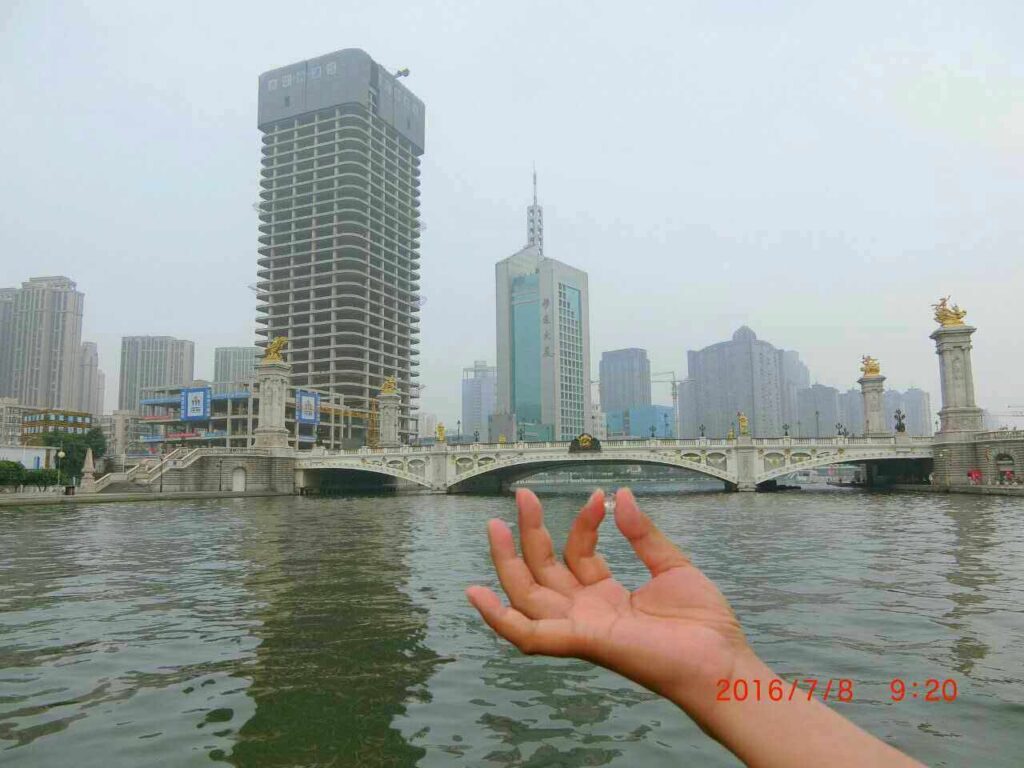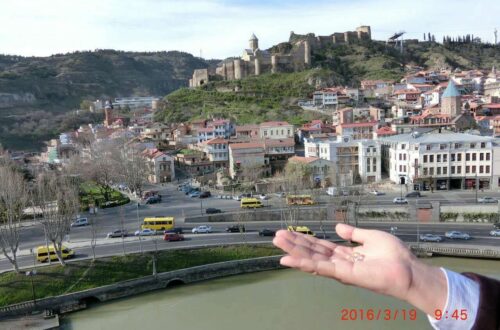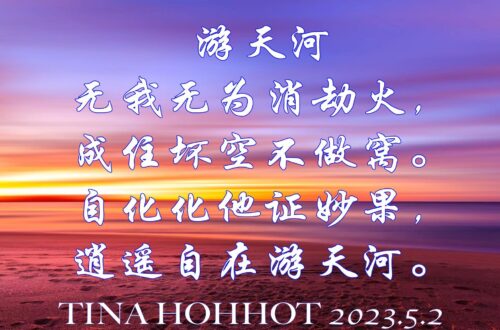Spreading Zen In the Orient

Spreading Zen In the Orient
Jan /14/ 2023 – Jan / 15/ 2023
There was a young man who was living with his mother; the only way he made his living was selling firewood. One day he delivered some firewood to a shop when he was about to leave; he heard a guest was reciting a sutra. As soon as he heard the text of this sutra, his mind at once became enlightened. Thereupon the young man asked the guest the name of the book and inquired whence he came and why he recited this particular sutra. The guest replied that he came from Dong Shan Monastery in the Huang Mei District of Qi Zhou, that the Abbot in charge of this temple was master Hongren, the Fifth Patriarch of Zen; that there were about one thousand disciples following him. The guest attended lectures on this sutra, and he told the young man that the master Hongren used to encourage the laity as well as the monks to recite this scripture as by doing so they might realize their own essence of self-nature and thereby attain Buddhahood directly by seeing self-nature.It must be due to the connections from past lives when I was such longing to visit master Hongren, and I was given ten taels for the maintenance of my mother by a man who advised me to go to Huang Mei to visit the Fifth Patriarch of Zen.
After three months of travelling, the young man finally met the master Hongren. When master knew that the young man was from Xinzhou in Canton, he asked the young man: “You are a native of Guangdong, a barbarian? How can you expect to be a Buddha?” The young man said: “Although there are northern men and southern men, north and south make no difference to their Buddha’s nature. A barbarian is different from monk physically, but there is no difference in our Buddha-nature.”
“This barbarian’s faculties are too sharp.” master Hongren remarked and took the young man in, gave him a name as Huineng. Huineng then withdrew himself to the back yard and pounded rice for eight months.
The master Hongren assembled all his disciples one day, he said:” Go and seek for Prajna (wisdom) in your mind and then write me a stanza (gatha) about it. He who understands what the Essence of Mind is will be given the robe (the insignia of the Patriarchate) and the Dharma, and I shall make him the Sixth Patriarch. Go away quickly and do not delay in writing the stanza as deliberation is quite unnecessary.” Having received this instruction, the disciples withdrew and said to one another, “There is no necessity for us to write the stanza and submit it to the master since the position of Patriarchate is bound to be won by Shenxiu, the sthavira of temple and he is so brilliant. If we write perfunctorily, it will only be a waste of time.” Shenxiu eventually wrote a stanza:
Our body is the Bodhi-tree,our mind is a bright mirror.
carefully we wipe the mirror often,and let no dust alight.
The sanza was written on the wall, and everyone knows who is the writer although Shenxiu didn’t sign his name on it. When master Hongren saw it, “Your stanza,” said the master, “shows that you have not yet realized the original nature. So far you have reached the ‘outside door of enlightenment’, but you have not yet entered it. You’d better go back to think it over again for a couple of days, and then submit me another stanza.”
Two days after, it happened that a young stylite boy who was passing by the room where Huineng was pounding rice recited loudly the stanza written by Shenxiu. Huineng asked the boy to show him where the stanza was and wanted to make obeisance to it as he had been pounding rice there for eight months and never been to the hall. The boy took Huineng there, and Huineng asked him to read it for him as he was illiterate. A petty officer of the Jiang Zhou District named Zhang Ri Yong who happened to be there, read it out to Huineng. When he had finished reading Huineng told him that he also had composed a stanza and asked the officer to write it for him. The sanza was as follow:
There is no Bodhi-tree,Nor stand of a mirror bright.
Since all is void,Where can the dust alight?
When he had written this, all disciples and others who were present were greatly surprised. Filled with admiration, they said to one another, “How wonderful! No doubt we should not judge people by appearance. How can it be that for so long we have made a Bodhisattva incarnate work for us?”
Seeing that the crowd was overwhelmed with amazement, the master Hongren rubbed off the stanza with his shoe and said that the author of this stanza had also not yet realized the essence of self-nature.
Next day the Patriarch came secretly to the room where the rice was pounded. Seeing that Huineng was working there with a stone pestle, he knocked the mortar thrice with his stick and left.
Knowing what his message meant, in the third watch of the night Huineng went to master’s room in the midnight. Using the robe as a screen so that none could see them, master Hongren expounded the Diamond Sutra to Huineng. When he came to the sentence, “One should use one’s mind in such a way that it will be free from any attachment”, Huineng suddenly realized that all things in the universe are the essence of self-nature.
“How unexpected? The self-nature is originally pure in itself.
How unexpected! The self-nature is originally neither produced nor destroyed.
How unexpected! The self-nature is initially complete in itself.
How unexpected! The self-nature is original without movement.
How unexpected! The self-nature can produce ten thousand dharmas.”
The master Hongren knew of Huineng’s enlightenment to his original nature and said to him, “Studying the Dharma without recognizing the self-nature is of no benefit. If one recognizes one’s own original mind and sees one’s original nature, then one is called a great hero, a teacher of haven beings and humans, is a Buddha.” After saying this, master transmitted the robe and bow to Huineng .
The master further said: “When the Patriarch Bodhidharma first came to China, people did not believe in him yet, he transmitted this robe as a symbol of faith to be handed down from generation to generation. The Dharma is transmitted from heart to heart, leading everyone to self-awakening and self-enlightenment.
From time immemorial, it has been the practice for one Buddha to pass to his successor the quintessence of the Dharma, and for one Patriarch to transmit to another the esoteric teaching from the heart to heart. As the robe may give cause for dispute, you are the last one to inherit it. Now leave here as soon as possible, lest someone should hurt you.” The master Hongren escorted Huineng to the Chiu Chiang courier station and ordered Huineng to board a boat. Huineng asked the master to sit down and wanted to take the oars by himself. Master Hongren said: “It is destined that I take you across the river.” Huineng then replied: “When someone is deluded, his master takes him across, but when he is enlightened, he takes himself across. Although the term ‘taking across’ is the same in each case, the function is not the same.Huineng was born in a poor frontier family, and my accent was not nice, yet I have had the honour to inherit the Dharma from you. Since I am now enlightened, it is only right for me to cross the sea of birth and death myself by realizing my own self-nature.”
After that, Huineng followed the advice of Master Hongren; he hid in a hunter group for 15 years. One day Huineng bethought himself that he ought not to pass a secluded life all the time and that it was high time for him to propagate the Dharma. Accordingly, he left there and went to the Fa Xing Temple in Canton.
At that time Bhikkhu Yinzong, Master of the Dharma, was lecturing on the Maha Parinirvana Sutra in the temple. It happened that one day when a pennant was blown about by the wind, two Bhikkhus entered into a dispute as to what it was that was in motion, the wind or the pennant. As they could not settle their difference, Huineng submitted to them that it was neither and that what actually moved was their own mind.
The whole assembly was startled by what Huineng said, and Bhikkhu Yin Zung invited Huineng to take a seat of honour and questioned me about various knotty points in the Sutras. Seeing that his answers were precise and accurate and that they showed something more than book-knowledge, he said to me, “Lay Brother, you must be an extraordinary man, I was told long ago that the inheritor of the Fifth Patriarch’s robe and Dharma had come to the south. Very likely, you are the man.”
Huineng admired it and showed the rope and monk bowl to everyone. Bhikkhu Yinzong was highly pleased with it; he put his two palms together as a sign of respect said, “My interpretation of the Sutra is as worthless as a heap of debris, while your discourse is as valuable as genuine gold.” Subsequently, he conducted the ceremony of hair-cutting for Huineng and asked Huineng to accept him as a student. Since that, Huineng started to teach people and spread Buddha’s Dharma from Faxing Temple.
After the six Patriarch Huineng, Zen masters only expound the Dharma to their students and never transmit the robe and monk bowl again. According to the sanza from Bodhidharma, the first Patriarch of Zen, it read:
My aim of coming to this country, Was to transmit the Dharma and liberate all the beings, A flower with five petals Can not fail to the fruit.
Although there was no transmission of the robe, the root of Zen in China was genuine and ripe. After Master Huineng’s parinirvana, his students spread the Dharma to the different area of China, Caoxi Zen was divided into Caoxi north and Caoxi south. Caoxi North was also called Heze school while Caoxi Southern divided to stone school, Hongzhou school. From the late Tang Dynasty to the early Song Dynasty, there were mainly five schools in China, which named Linji school, Caodong school, Cloud Gate school, Fa-yen school Weiyang school, with Huanglong group and Yang Qi group which were originally from Linji school, people call them five schools and seven groups. However, only Linji school and Caodong school have existed after the Song Dynasty.
From 5 Dynasties and ten kingdoms to Tang and Song Dynasties, Zen took root in China and attained a period of great prosperity, but Zen’s influence wasn’t only affected China. China and Japan got more often communication in the culture since the Tang Dynasty. Buddhism was introduced in Japan in the 8th century Zen was not introduced as a separate school in Japan until the 12th century during the Kamakura period and the first Zen temple was built by a Japanese monk whose name was Myoan Eisai in 1192. In 1168, Eisai travelled to China, whereafter he studied Tendai for twenty years. In 1187 he went to China again and returned to establish a local branch of the Linji school, which is known in Japan as the Rinzai schoo. Myoan Eisai was the first person who introduced Zen to Japan. Today,the traditional schools of Zen in contemporary Japan are the Sōtō, Rinzai, and Ōbaku. The well-known vocabulary “Zen” is also from Japanese, not original Chinese. In Chinese, we call it “chan”.
I found that in the United States and Canada, most people know “Zen” and not very many people know the pronunciation of original “chan”, why? Because the “Zen” you’ve realized today was came from Japan to North America.
At the beginning of the 20th century, a Japanese person named Suzuki Okazaki spread
Rinzai Zen in the United States for a long time so that the Zen school which accepted by occidentals was Rinzai Zen, however instead of a Zen master Mr Suzuki was more like a scholar. With fluent English and a combination of Zen and Japanese culture, he made a great speech at the World Congress of Religions which held in Chicago, United States. With Mr Suzuki’s promotions, “chan” voyaged into the occidental world with a “Zen” mark which was carrying Japanese culture together. Thereafter, Suzuki Okazaki taught at Columbia University and other universities to further spread the Zen culture. Suzuki has written a series of popular books like “Zen and Japanese Culture”. In these books, “Zen” was closely connected with bushido, kendo and tea ceremony. With the double admiration of the quiet senses and extreme courage of the inner world, the original teachings from Buddha, such as not rely on speeches and the special transmission outside of the scriptures, such as the heart-to-heart teaching was superseded by purely Japanese-style Sensory. This purity weakens the comprehensiveness and depth of the fundamental belief in Buddhism. Through the “flying over the Pacific Ocean,””Zen” has become an independent spiritual experience which came from the mysterious Orient, with a strong sense of ritual, pursuing leisure and calmness from the inner world, which of course satisfied the curiosity of oriental religion also attained the basic needs of the majority. Therefore Zen became very popular and spread rapidly in the United States. Today, Zen has become the standard symbol of “chan” Buddhism in the Western world. However, Japanese “Zen” pays more attention to the material; they encourage people to pursue their inner peace by doing something special like cooking tea, rather than focus on originally heart and self-nature Practice. With Japanese Zen spreading in the western society, instead of pursuing the enlightenment, Zen masters promoted Buddhist precepts and Dharma to the secular humanism.
What I want to say is that as a true practitioner and a practitioner who wants to attain the enlightenment, we should return to the tradition, keep the precepts and pursue enlightenment instead of spending some time to experience the oriental lifestyle. I did not say that the experience of “Zen” is not good; I just believe the wise and kind people like you deserve something insightful. After all, when Sakyamuni Buddha enlightened,
what he said was: Strange indeed! Strange indeed! Strange indeed! All living beings have the wisdom and virtue of the Thus Come One, yet because of their idle thoughts and attachments, they fail to realize it.” At this point, he set up the Buddhism, taught us to see our self-nature which is nothing different from Buddha’s nature, to discover our own potentials and thus we could eventually become Buddha, and this is the original intention of the Zen.
Therefore, open your mind, feel the unique connection between you and Buddha in the upcoming blessing chanting, Wishing you all the blessings of a beautiful New Year.
Thank you for your listening!






10 Comments
buy real followers tiktok
I truly love your website.. Excellent colors & theme.
Did you create this site yourself? Please reply back as I’m wanting
to create my own personal blog and would love to find out where you got this from or what the theme is named.
Kudos!
buy 100 real followers on instagram
I could not resist commenting. Well written!
usdrmc2022
thank you so much,I appreciate your comment.
Christoper
Peculiar article, exactly what I wass lookiing for.
Tina Du
:)
https://wwd.com/business-news/business-features/how-to-get-more-instagram-followers-1235787837/
What’s up to all, how is the whole thing, I think
every one is getting more from this web site, and your views are
nice for new users.
Aundrea
You really make it seem so easy together with your presentation however I
to find this topic to be actually one thing that I feel I’d never understand.
It seems too complex and very broad for me. I am looking ahead
in your next put up, I’ll attempt to get the dangle of it!
Hellen
Excellent post. I am going through many of these issues as well..
Susanna
I enjoyed reading this article and learned some fresh perspectives on the topic. Thanks for sharing your insights.
Kendall
Your blog captivates me from the beginning to the end. I can never scroll away without devouring your entire post.